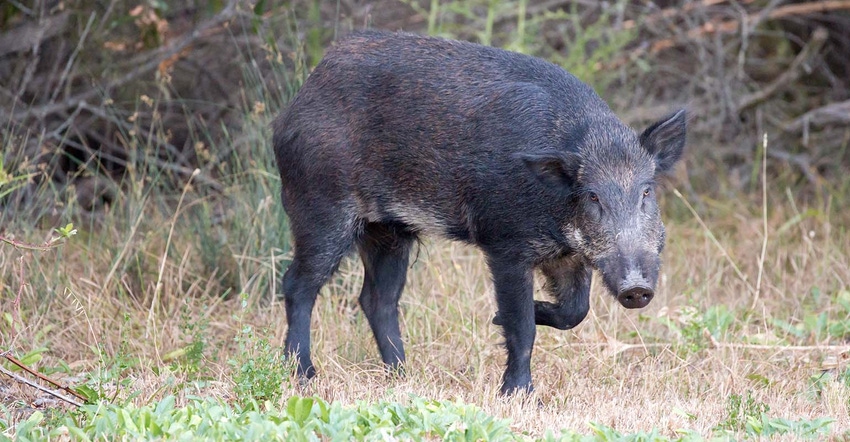August 23, 2021

Feral pigs are big – some weighing over 400 lbs – but the potential problem they pose for the US pork industry, ranchers and crop farmers is much bigger.
Feral pigs are now found across most US states and several Canadian provinces. In the US, they could number as many as 9 million at this point, and in Texas alone, at least 2.6 million.
According to the Texas Invasive Species Institute, it was likely Spanish explorers who introduced European pigs to North America over three centuries ago. Then, in the 1900s, European wild boars were brought to Canada and the US for meat production and sport hunting. Some perhaps escaped, some were set free, but one thing is for certain – feral pigs have never looked back.
These hogs are hard to stop, but a new approach targeting males could make a difference for the future.
These animals are a menace in many ways. They cause over a billion dollars of crop damage each year, decimate wildlife habitat, attack young and pregnant livestock, and have killed at least one person. They’re also potential carriers for at least 30 diseases of humans, livestock, and wildlife.
For commercial pork operations, they are a disease threat for swine brucellosis, pseudorabies, classic swine fever and African swine fever (not currently present in North America but has been spread around Europe in recent years by wild boars).
Feral hogs don’t just stick to ranch land and forest, but also make their way into urban areas in Texas and many other states. In April this year, families in Dallas complained about wild pig presence in cemeteries. In soft soil, these animals can root for food three feet down.
Texas Parks and Wildlife estimates that annual population control efforts would need to continuously achieve 66-70% population reduction just to hold the wild pig population at its current level. With current control methods, however, yearly population reduction only reaches about 29%.
Methods of feral hog control
Control of wild pigs has been attempted through many avenues, like fencing, snare traps, cage traps and traditional hunting. They have made little difference.
The Texas government passed a law in 2011 allowing shooting of feral pigs from helicopters. That bill was proposed by now-Agriculture Commissioner Sid Miller. Miller also proposed a controversial plan to poison hogs but it did not proceed. In 2017, the state of Texas also approved the hunting of feral hogs and coyotes from hot air balloons. It’s cheaper than helicopters, quieter and offers a more stability.
However, research has shown that hunting can boost feral pig populations, and as such, it’s not recommended in states such as Montana, or in the province of Ontario, Canada. Hunting causes the pigs to adopt more savvy behaviors, to become more nocturnal and venture into new areas that might be safer, growing their population all the while. Feral hogs can produce a new litter every three months or so, with litters of 10 or more.
However, in June, a new male contraceptive launched in Texas and other southern US states, fully supported by Commissioner Miller. “It works,” says Miller. “We’ll have to be committed to it for a couple of years.”
A different approach to stop feral hogs
HogStop is the contraception product that launched in June and was developed over the last few years by Dr. Dan C. Loper and his team, which includes his son Daniel.
For the past three years, they’ve been testing the product on commercial boars, and found a 60% reduction in sperm motility. The product also causes changes to sperm morphology – and taken altogether, the effects significantly reduce fertility, explains Daniel Loper. These results have been observed even in boars that had ingested the product only over five days.
The active ingredients of HogStop are proprietary but are described as a “mixture of natural feedstuffs.” There are no hormones or endocrine disruptors in the product, nor does it actively work to affect hormones. It stays in the testes of a boar and does not travel throughout the boar’s body, according to the company.
It should only be fed in hog-specific feeders designed to keep out all other species, as males of other species such as deer can be affected similarly if large enough amounts are consumed.
HogStop officially recommends two feeders. The ‘Barclay Feeder’ has a weighted pressure plating system and a ‘scent grate’ at the lower front to attract hogs. The other feeder, WPF, is a patented pig-specific feeding system that keeps out larger animals with ‘bear bars.’ It comes with optional remote monitoring of feeder use and feed level.
The product is already categorized as an approved ‘25 (b)’ pesticide by the US Environmental Protection Agency. Because of this, it’s likely that HogStop will be a tax-deductible expense for farmers and ranchers in the US. This is expected to speed adoption. It is currently being sold through the South in partnership with U.S. feed manufacturer and distributor Hipro.
Loper adds that approval for use in all US states and other countries is in the works. It’s just received approval in Oklahoma. In the meantime, the HogStop team has already received calls from extension personnel, scientists and more in Europe, Israel, Australia, and Canada for use on feral deer, pigs and mice.
In mid-August, Loper reported that sales have expanded. “Word of mouth is spreading rather quickly now, and we are due to give talks at an extension agent meeting and a meeting for a water and soil conservation group in September,” he says. “Our feeder guy in Texas has sold out of all the feeders he had made and has orders for more.”
Learn more at hogstop.com.
Hein covers agriculture from Ottawa, Canada.
You May Also Like




